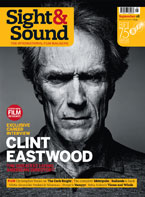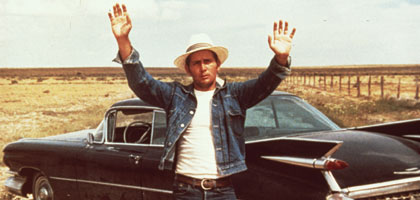Primary navigation


Terrence Malick's debut was a hymn to the lost West, a brutal dissection of the American dream and even a screwball comedy humming with snappy lines. David Thomson rediscovers the re-released Badlands
There have always been movies where the sign 'badlands' was a significant warning - Badlands of Dakota (1941), Badlands of Montana (1957) and just plain Bad Lands (1939). These are minor films, ones we may not need to remember, but in each the term stands for a place you just don't want to be. Historically 'badlands' meant a part of South Dakota and Nebraska, a place where nothing ever grew or flourished. And 'badlands' is also used to signify a terrain of buttes and mesas, beyond farming or habitation. We don't see that land in Terrence Malick's film, a picture in which the flat desolation of the ground is part of a tale of casual slaughter's beautifully composed lack of affect. But Malick's landscape isn't an area of barren hopelessness either. The place where Kit and Holly head - out of South Dakota and into Montana - is a strange playground where Carl Orff and Erik Satie's music accompanies the reckless dreams of uneducated kids. They have such unsmiling fun.
Here's an interesting question about the movies. When they came to shoot the final climbing-the-staircase scene for Now, Voyager (1942), Bette Davis is supposed to have turned to the crew and asked, “Well, am I going up those stairs - or is Max Steiner?” She meant the house composer at Warner Bros. who had scored, uplifted or saved at least ten of her films by then. Bette could imagine the Steiner music still to come. So here's the question: should the music in films be music that the characters might know? Or if, as in Badlands, the sweet intrusion of so much 'good' music (better than Max Steiner?) is noticeable and seemingly remote from the kids, does it mean that the deadpan tone of teenagers from the late 1950s and the listless rural twang of Sissy Spacek's narration are being very deliberately and artistically distanced by the watchful presence of someone as smart as Terrence Malick? If so, what does that do to what we feel?
This relates to the vital question of whether we are 'with' these kids or whether we are studying them - to which it's surely reasonable to reply “can we try both?” For myself, I still love Badlands and feel haunted by its unlikely clash of immediate horror and long-distance wistfulness. But that's the problem we have to address.
In 1973-74, as Badlands opened (its premiere in London was at the old Academy, not as a regular theatrical entertainment) it was easy to see the film's set-up as another version of two wild and frustrated kids going on the lam, 'breaking out' and breaking into the mythic space of the American frontier: the film was heavy with nudges about Kit Carruthers (Martin Sheen) looking like James Dean. And in the Monthly Film Bulletin, Jonathan Rosenbaum's alert eye saw the first shot of Kit working the garbage truck in Fort Dupree, South Dakota, as a reference to Rebel Without a Cause (1955). But any plans for a film about an alienated kid who wants to escape the traps set by life are quickly dashed.
Nicholas Ray would have soaked us in Kit's backstory - a tortured home life (so no going home), wretched schooling, premature delinquency, a rough life on the road and a deep if inarticulate denial of the values of Eisenhower's America. Malick's Kit does not buy that package. There is no backstory, beyond our feeling that “Kit Carruthers” is a fancy and suspicious name for so chronic a faker (the model in history was named Charles Starkweather). Kit is a life force and a trickster, beyond pity or social diagnosis. He is vicious, comic, image-fixated - close to crazy. And Sheen plays him with a thoroughly cool detachment that simply underlines how much Dean always ached for pity. Kit is a psychopath given to all manner of conversational curlicues. He can hardly say anything, or hear anything said without adding some trite Reader's Digest footnote. “What you doing?” he asks a man he has kidnapped. “Just thinking,” says the scared guy. Kit chips in with his usual smartass flourish and some fancy nihilism - “As good a way to kill time as any.” He is somewhere between Sam Goldwyn and Wittgenstein. (“Aren't we all?” I hear him reply.)
Nick Ray never made a film in which a hero wants to kill time - yet Malick seems to view killing time and offing other people as part of the same behavioural spectrum. Early on we meet and say farewell to Holly's father, played by Warren Oates. He is Ray-like, I suppose, in that he blindly opposes her friendship with Kit, and brutal - he kills her dog when she keeps seeing the garbage boy. But Malick sees so much more. There in Fort Dupree, South Dakota (a dot, if you can find it), the father is a sign painter ready for the Tate Modern. There is a moment when Kit comes to see him. He gets out of his car and the camera follows his movement to reveal a composition of utter and immodest grandeur - a huge primitive picture that the father is painting with the sky itself (just as naive and vivid) behind it. The father may kill Holly's pets but he is some kind of a genius. But very soon Kit pops him - bullets in the chest - and then leaves the body to burn in the torched house. (As Kit pours gasoline on the open piano, Malick hears a sliver of melody.) Holly watches this and goes with the killer as if she's following a movie and feels too bored to resist (boredom is always close to these kids' fun, and Malick stirs it as if fascinated by a sleeping snake). It's not just that the parental bond counted for too little; it's more that fondness doesn't register in this picture. And that's what the music supplies: it fills in the empty spaces around this murderous ritual and makes it resemble a languid dance for insects.
I admit that I'm thinking here of the Malick who has shown more and more interest in such effects - and less and less in people. I find the beauty-versus-detachment issue increasingly troubling in The Thin Red Line (1998) and The New World (2005), and I note with some foreboding that the next Malick picture Tree of Life seems to be about a plant. But the human encounter in Badlands is still austere, resonant and original and it lets us see how far, by the 1970s say, the Ray-like human tangle had become an American cliché. Throughout Badlands we keep asking the question: why Kit and Holly? What depth or need in human nature are they illustrating? Or is their collision chance?
It's not sex, no matter that in the film Kit is 25 and Holly 15 (Sheen was 32 and Spacek 22). As so often, these high-school dropouts are horribly mature. But they try sex (off camera) and we come in on a buttoning-up moment with talk about it being a lot of talk. They carry on regardless because it may be unflawed childish fusion that they seek. That takes many forms - dancing in the dust to 'Love is Strange' by Mickey and Sylvia, living in their tree house and engaging in deadpan dialogues where Spacek's voice is the lovely druggy counter to Sheen's muttered boastings. Given the real age of the actors and the recessive youth of the characters, this must have been very hard to play. Spacek is the child who can see her father murdered without dismay, the stunned face that observes the drab wilderness and the shy, tired girl who at last opts out of Kit's careering advance (so much subtler an abdication than Bonnie's wish not to see the end of it all in Bonnie and Clyde). As for Sheen, here we can see the great actor who slipped away into such steady, worthy things as The West Wing. Kit is maybe the gentlest, chattiest psycho in American film, a talksmith who performs the verbal equivalent of card tricks to defy the banality of small talk. After he has shot his fellow garbage-worker Cato for no apparent reason, Holly asks, “Is he upset?” (Cato is dying.) “He didn't say anything to me about it,” replies Kit.
Such talk is not just a tic, a silly answering back. It's a kind of grim screwball comedy - or a realisation that this America has gone past the point where it can take serial killing simply for what it is. The gap between murder and laughter is now itself a joke, and the cowboy sheriffs who eventually nail Kit are parodies of old-time posses, feeding on Kit's celebrity, his greasy comb and the way he looks like that Dean guy. I had not realised until my most recent viewing how far Badlands is poised on the edge of being a comedy - and I suspect that at the time it was made that verdict was far from the minds of the makers. But that is how art can push up concrete if it is a strong enough green shoot. The music by Orff and Satie is not pretentious, but comically ambitious. Sheen's deft sparring with words lampoons a society where everyone else speaks with monumental simplicity - though Holly is clearly a wishful creative writer who speaks in sentences probably written in purple crayon in her exercise book.
So what I see now is a screwball Western, with a visual beauty that marks the way the West has been turned into a set of pretty picture postcards. A lot of these new Westerns are oblivious of the old Western code (so Cato is shot because he is there and out of some half-remembered habit - if you have a gun, fire it). Kit Carruthers is a killer who could as easily have been a crooked realtor in Las Vegas - “You want a shower, run the water a minute first - flush the snakes out. Think I'm joking?” He is selling himself as a heroic poet and so at the end, as the law closes in, he makes a last date with Holly, to meet at high noon on New Year's Day 1964 at Grand Coolee Dam. Of course, he is dead by then. (In the movie Holly's voiceover says she ended up marrying her defence lawyer, but that trial would have required Preston Sturges.)
Terrence Malick's career is very rare and precious - if for no other reason than that rarity. He is 65 now and in his most active phase. He is an amiable recluse - you can meet him and have dinner and he is very good company - but he simply can't abide talking about his films. For him to maintain this stance a certain mystery needs to attend the works themselves. For me that mystery is there as surely in Badlands as it has turned into prettification or a kind of botanist's blind alley in the recent films. Days of Heaven (1978) is in-between, close to Badlands in narrative form and increasingly aware that the American West that Malick loves to see and show is one that hardly needs people. Meanwhile, Badlands is, at the very least, one of the great American debuts. And once you've got Kit's nagging voice in your head, there's no escape, no refuge.